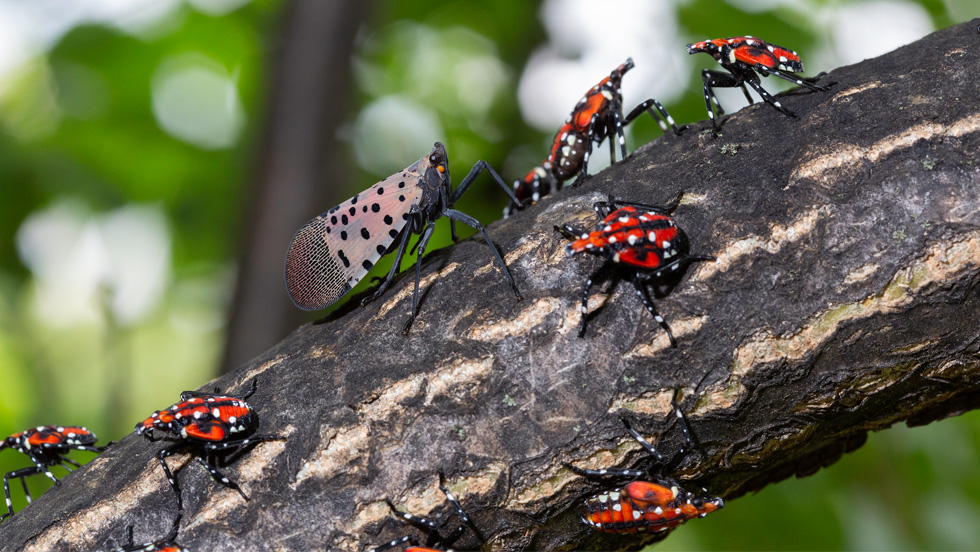
As the insect gains a foothold in the Northeast, Adelphi is prepared to stamp out this threat.
In the last few years, the Adelphi grounds crew has joined the northeastern United States search-and-destroy mission related to a pesky insect: the spotted lanternfly.
The spotted lanternfly (scientific name Lycorma delicatula), an invasive species inadvertently brought to this region by shipping crates in 2014 from the insect’s home region of Asia, was first seen in New York in 2020—though this year it appears to have become more common in some areas. While it doesn’t hurt humans or other animals, large numbers of the lanternfly can damage grape vines, posing a threat to Long Island’s and upstate New York’s vineyards.
Right now, the approach most government entities and environmental organizations are taking is to hold down the geographic spread of the insects by swatting or stomping on the adult flies or the beetle-like nymphs earlier in the summer—at least until scientists and horticulturalists figure out ways to better control them. This fall and through the winter, removing egg masses will also help control the population next year. Each mass contains about 60 eggs.
“Every morning, four grounds people police their area of campus; they check for various things such as insects, the health of lawns, plant diseases, along with picking up trash,” said Robert Conaghan, associate director of facilities management. “We’ve seen some of the lanternflies and stomped on them when possible, but the numbers are overall pretty low so far. We’ve seen several on the Nexus Building—they seem to like the orange color or maybe the light it emits.”
Conaghan and Robert Shipley, assistant vice president for facilities management, have reached out to the campus arborists for guidance as they do for any large gatherings of insects or egg masses—in this case, just a potential issue so far. Locally, the spread has been most visible west of Garden City, in New York City and the Hudson Valley. The lanternfly’s favorite host is the tree of heaven (Ailanthus altissima), another invasive species from Asia that was introduced in the United States in the 1700s as a fast-growing shade tree—something that fortunately is not found on Adelphi’s 70-acre campus.
“I’ve seen a few lanternflies on campus,” said Matthias Foellmer, PhD, professor of biology, whose courses include botany and ecology. “But they’re not as much of an issue yet as it is in the larger metropolitan areas including New York City, DC, Baltimore and Philadelphia.”
Dr. Foellmer notes that currently individuals are encouraged to report sightings of the lanternfly outside Nassau County, New York City, and Westchester and Rockland counties. He, in fact, was one of the first people to report the insect. “I saw it in 2020 in Fort Tilden Beach,” he said. “I had no idea what that thing was, so I took a picture and uploaded it to iNaturalist.”
While the insect prefers the tree of heaven, it can feed on at least 100 other species. “It’s the irony that the invasive plant gets an invasive bug to go with it,” Dr. Foellmer said. “There are pesticides approved for food crops, but biological control is preferable to dangerous pesticides—for example, there is a fungus that attacks the lanternfly that is being considered as a possible option.”
Adelphi’s practice of eliminating the use of most chemical insecticides will continue for now, with the anticipation of a more environmentally friendly method for control coming in the near future.
What can members of the Adelphi community do to help contain the lanternfly invasion?
“Kill them on sight,” Conaghan said. “We’ve had several people call about sightings, but at this point, no need to do that unless one sees a large bunch. Right now there are no recommendations for other ways to control them, but if the situation worsens, we’ll address it as the science develops.”
See more about the spotted lanternfly from the New York State Department of Environmental Conservation.